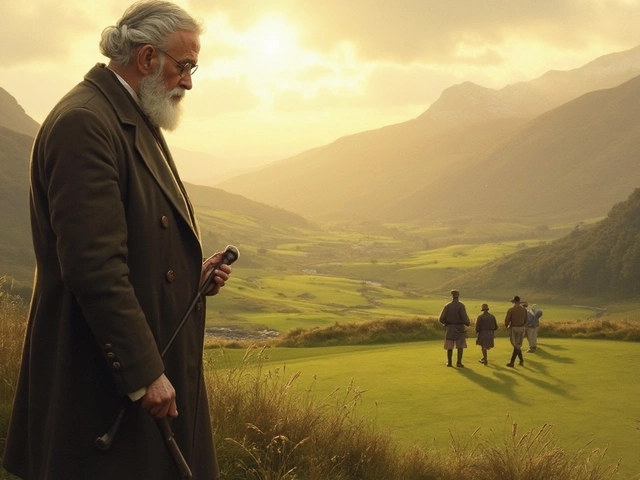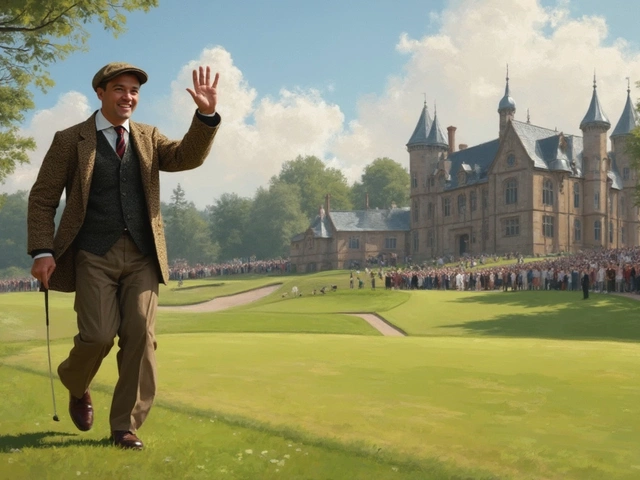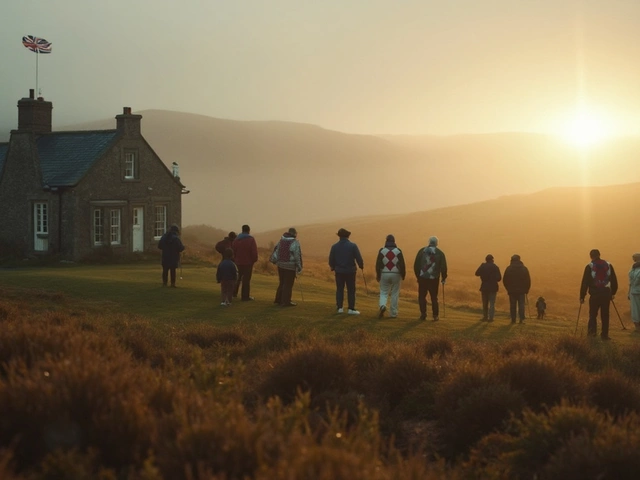King of Golf: Who Holds the Crown and Why It Matters for Golf Courses

If you ask a bunch of golfers who the king of golf is, you’ll probably trigger a heated debate. Still, the majority of old-school fans throw the title straight at Arnold Palmer. The man wasn’t just a killer on the course—he was the sport’s superstar before golf was even cool. Walk into almost any clubhouse, and you’ll spot his signature somewhere; talk to course managers, and they'll say he’s as much a household name as the Masters itself.
The whole ‘king’ thing isn’t just fan hype. Arnold Palmer won 62 PGA Tour titles and completely changed the game’s vibe. Suddenly, golf stopped being a stuffy sport for elites and became something people of all backgrounds wanted to try. He brought energy, bold shots, and a ‘let’s just go for it’ attitude. If you ever stand on a public course tee box and see a group of amateurs chasing birdies, Palmer helped set that scene.
- Who Really Is the King of Golf?
- Why the Title Sticks: Stats and Stories
- Nicklaus, Woods, and the Debate for the Throne
- Impact of the King on Modern Golf Courses
- Tips from the King You Can Use Today
- Fun Facts: Kings, Courses, and Crowns
Who Really Is the King of Golf?
So, who actually holds the title king of golf? The answer is Arnold Palmer—just about anyone who’s followed golf for a while will agree. Palmer didn’t give himself this nickname; the fans and the media did. Back in the 1960s, he ruled the fairways with a fearless playing style, a huge smile, and a habit of pulling off comeback wins when the cameras were rolling.
Palmer’s pro career exploded starting with his first Masters win in 1958. He ended up snagging four Masters, two British Opens, and a U.S. Open, racking up 62 PGA Tour wins overall. Consistency like that is super rare, even by modern standards. What really locked in the “king” reputation, though, was his popularity. He built what people called “Arnie’s Army”—fans who followed him everywhere, making big tournaments feel like concerts. Golf just hadn’t seen anything like that passion before.
Even after his playing days, Palmer kept shaping the golf world. He designed over 300 golf courses in more than two dozen countries. These aren’t all super-private clubs either; his goal was to make golf way more accessible and fun for regular folks.
Here’s a quick breakdown of why Palmer gets the crown:
- 62 PGA Tour wins, putting him fifth all-time
- Popularized TV golf—he brought the game into living rooms all across North America
- Bridge-builder between elite tour golf and the everyday public course scene
- Massive influence in course design, turning out playable and beautiful layouts for all skill levels
Plenty of big names have come up since, but nobody else changed the face of the sport like Palmer. If you’re hearing “king of golf” tossed around, it’s almost always a nod to Arnold Palmer.
Why the Title Sticks: Stats and Stories
Arnold Palmer picked up the "king of golf" nickname for a reason—his numbers and his stories pretty much sealed the deal. First off, nobody talks about golf’s modern boom without mentioning Palmer. He racked up 62 wins on the PGA Tour, which puts him in the all-time top five. That alone is wild. But dig a little deeper and you find a stack of trophies from seven major championships, including four Masters wins. That green jacket pretty much belonged to him in the early ‘60s.
His game wasn’t about playing it safe. Palmer popularized the "go-for-broke" style that still inspires gritty shots today, especially on tough golf courses. Fans loved it. TV loved it. Suddenly, golf matched baseball and football for drama. Even non-golfers got hooked—Palmer’s Army (his wildly loyal fan base) helped golf jump into living rooms across North America.
- First golfer to win $1 million in career earnings on the PGA Tour
- Voted PGA Player of the Year twice (1960, 1962)
- Inducted into World Golf Hall of Fame, 1974
- Known for helping kick off The Golf Channel—still a staple for golfers today
| Major Championship Wins | Year(s) |
|---|---|
| Masters | 1958, 1960, 1962, 1964 |
| The Open Championship | 1961, 1962 |
| U.S. Open | 1960 |
Palmer’s approach wasn’t just about trophies. He signed autographs for hours, talked to fans, and made everyone feel included. That’s a big part of why the title king of golf still sticks. He set the vibe for how today’s stars treat fans on and off the golf courses.
Nicklaus, Woods, and the Debate for the Throne
So, here’s where things get spicy. You can’t drop the phrase king of golf into any group chat without hearing the names Jack Nicklaus and Tiger Woods. Arnold Palmer might have kicked open the doors, but Nicklaus and Woods stomped through with records that made even casual fans pay attention.
Jack Nicklaus, also called the “Golden Bear,” racked up 18 major championships—a record that still stands. That’s not just a brag; it’s the standard for greatness in golf. He also won 73 PGA Tour events and had a knack for turning up the heat when the moment was huge. People still argue that when it comes to pure tournament wins and all-around consistency, Nicklaus owns the throne.
Tiger Woods, though, changed everything. He’s got 15 majors (so far) and 82 PGA Tour wins. He brought an athlete’s intensity to golf that nobody had seen before. TV ratings spiked, golf gear sales boomed, and suddenly, even non-golfers knew about "Tiger on Sunday." Watching Tiger pull off impossible shots or make crazy comebacks became the norm for a whole generation.
- Nicklaus: 18 major wins, known for focus under pressure and long-term dominance.
- Woods: 15 major wins, 82 PGA Tour wins, and the face of modern golf.
Arguments online usually go like this—Nicklaus has more majors, Tiger has more PGA Tour wins. But Tiger played in a much more global, tougher field. On the flip side, Nicklaus performed against legends like Palmer, Player, and Watson. Everyone’s got an angle.
Here’s a quick comparison if you’re torn:
| Golfer | Majors Won | PGA Tour Wins | Era Impact |
|---|---|---|---|
| Jack Nicklaus | 18 | 73 | Dominated 60s–80s, set the gold standard |
| Tiger Woods | 15 | 82 | Transformed golf’s global image since 1997 |
No matter which stats you care about, both guys pushed the limits and set new benchmarks. The debate isn’t just bar talk—it shapes how courses get built and how people play the game today. If you’re chasing your personal best, just remember: every era has its king of golf, and that keeps the sport electric.

Impact of the King on Modern Golf Courses
Arnold Palmer—yeah, the original king of golf—left his fingerprints all over today’s golf courses. He wasn’t just playing them; he designed more than 300 courses across 25 countries, and you can see his touch on everything from sprawling resort layouts to friendly local clubs. Step onto any Palmer-designed track and you’ll notice generous fairways, speedy greens, and clever hazards that ramp up the fun for both pros and rookies.
The dude loved making the sport accessible. A lot of courses before Palmer felt exclusive, but by the ’80s and ’90s, you started seeing more public and semi-private places that took his family-friendly vibe. Plus, Palmer pushed for faster rounds—he wanted people to actually finish 18 holes before sundown. Because of him, a lot of golf courses started paying closer attention to pace of play and keeping things welcoming for all levels.
Even the business side of things shifted. Palmer helped boost golf course marketing—he made it cool to have a relaxed dress code, golf carts became part of the norm, and amenities like snack shacks by the ninth tee showed up everywhere. And let’s not forget philanthropy: Palmer’s Bay Hill Club in Florida hosts the top players each year and raises tons for charity.
“Arnold Palmer turned golf into a sport for the masses. His designs invite everyone to play—and that spirit still shapes the game today.”
—Golf Course Architect Digest, June 2022
Here are a few ways Palmer’s influence pops up on modern courses:
- Wider landing areas—less searching for lost balls, more actual playing
- User-friendly layouts that suit all skill levels
- Focus on pace of play and comfortable amenities
- Greens designed to be both fun and fair—no ridiculous slopes only a tour pro could handle
And here’s an interesting stat: According to the Arnold Palmer Design Company, in 2024 over 10% of America’s public-access 18-hole courses have at least some Palmer-inspired design elements. If you’ve played a round and spotted a plaque or signature bridge, there’s a real chance the king of golf had a hand in that course.
Tips from the King You Can Use Today
Arnold Palmer didn’t just leave his mark on scoreboards; he left a playbook you can steal from, no matter your handicap. Want to see why people still call him the king of golf? Start with how he played the game and handled himself off the course.
One of Palmer's big things was confidence, but not cockiness. He always backed himself to hit the shot, even if it looked risky. If you’re staring at a tough dogleg or a shot over water, remember how Palmer would take a deep breath and swing with purpose. Second-guessing messes with your swing, so commit and go for it. That’s real ‘king’ energy right there.
- Go for broke (within reason): Palmer believed in picking a line and sticking to it. If you decide on an aggressive shot, trust it, but know your limits.
- Practice the basics—always: Palmer never got too fancy. He drilled his grip, stance, and alignment every practice day. Even the golf legends know there’s no shortcut.
- Be speedy on the greens: He kept up the pace. Slow play frustrates everyone behind you. Make a decision, set up, and stroke it. Easy as that.
- Respect the course and the crew: Always fix your divots, rake bunkers, and thank the staff. He believed the real king of golf knows the real value of every place he plays, from major golf courses to muni tracks.
- Handle bad breaks like a champ: Palmer was famous for his positive attitude, even after a rough hole. Shake it off, don’t dwell, and move to the next shot with a clean slate.
Palmer’s handshake was legend—always strong, always looking you straight in the eye. The lesson? Play hard on the course but be genuine and decent to everyone. If you bring that mix of grit and respect, you won’t just play better golf; you’ll enjoy it a lot more too.
Need some quick stats to back this up? Check out this table from the PGA Tour showing how Palmer’s attitude translated to solid results, especially in the clutch:
| Stat | Palmer’s Record |
|---|---|
| PGA Tour Wins | 62 |
| Major Titles | 7 |
| Final Round Comebacks | 12 |
| Years in Top 10 | 15 |
Take a page out of the king’s playbook—your foursome will notice, and your scorecard just might thank you for it.
Fun Facts: Kings, Courses, and Crowns
Let’s be honest, every sport has its legends, but golf is stacked with ‘royalty.’ The guy who always gets called the king of golf is Arnold Palmer, and trust me, there are some wild facts and stories around this title.
First off, Palmer had an army—literally. ‘Arnie’s Army’ started as a few dedicated fans following him between holes during the 1958 Masters. Within a few years, that ‘army’ became the biggest gallery in golf, cheering for every gutsy putt and impossible recovery.
Did you know there’s a drink named after him? The “Arnold Palmer” (half lemonade, half iced tea) is about as famous on golf courses as a good driver off the tee. Order one in a pro shop café, and nobody bats an eye—they just pour it.
- Palmer’s popularity led to his own golf course design company, cementing his influence on actual golf courses around the planet. Over 300 courses worldwide bear his signature.
- He was one of the first golfers to fly his private plane to every tournament. That’s Bezos-level before Bezos was even a thing.
- The king signed so many autographs that autograph guides say his signature is still one of the most common and easy to authenticate in sports.
Curious about championship records? Check out this side-by-side table that puts the king of golf in context with other major legends:
| Name | PGA Tour Wins | Major Wins |
|---|---|---|
| Arnold Palmer | 62 | 7 |
| Tiger Woods | 82 | 15 |
| Jack Nicklaus | 73 | 18 |
None of these numbers tell the whole story, though. Palmer’s smile, respect for fans, and love for golf course architecture all fed his nickname. He wasn’t just racking up trophies—he was shaping the culture and vibe of the sport from tee-off to clubhouse.



